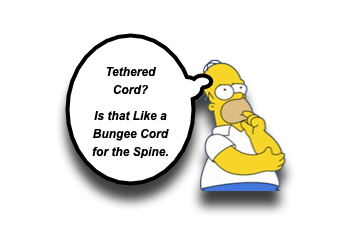Tethered Cord in Children
It seems that my patients teach me something new almost every clinical shift. Perhaps it is because I am getting older and have forgotten a lot. Maybe I have just seen more to ask questions about. I would like to think it is because I am receptive to learning… but let’s be honest, I am too lazy for that to be true. Whatever the reason, over the last several weeks alone they have educated me about how Compartment Syndrome can Chronic and how Honey can Heal. They have also reminded me of the hazards of Calcium Channel Blockers and Short QTc. Over the entire course of my training and career, they have taught me humility… something that we all could use more of now. Recently I cared for a child who had Urinary Retention. Since there was already a Morsel on this issue, I was certain I had a reasonable plan of evaluation… until I realized that Tethered Cord was on the list of considerations and I had not yet pondered that. Let’s take this moment to consider it now – Tethered Cord in Children:
Tethered Cord: Basics
- Tethered Cord Syndrome is one of the most common pediatric spinal disorders. [Sanchez, 2014]
- Causes progressive functional disorder.
- Due to pathologic fixation of the spinal cord in the vertebral column.
- It is related to a tight Filum Terminale. [Tu, 2013]
- Creates abnormal tension on the conus medullaris.
- Decreases normal mobility of the spinal cord (hence, “tethered”).
- Normal antatomy:
- The conus is fixed to the filum terminale, which is somewhat elastic.
- The filum terminale extends from the caudal portion of the conus (around L2) to S2 region and even beyond.
- The filum is thin, less than 2 mm in diameter.
- The filum helps to stabilize the conus and enables it to hang freely during normal spinal flexion and extension.
- Pathophysiology of the tethered cord [Sanchez, 2014; Tu, 2013]
- The exact etiology is not definitively known, but evidence points toward…
- Increased metabolic demands of the filum terminale.
- Eventually, an ischemic-type injury occurs.
- The filum become thickened and less elastic.
- Thickened and less elastic filum reduces mobility of the spinal cord and displaces the conus caudally.
- Occult Tethered Cord Syndrome (OTCS), lacks the displacement of the conus, but thought to also be due to less elastic and thickened filum terminale.
- “Adult onset” TCS can also occur and also thought to be related to:
- Less elastic filum (due to progressive fibrosis)
- Growth spurts (with adolescents and young adults)
- Increased physical activity with strain
- Spinal canal stenosis
- Tethered Cord Syndrome and Occult Tethered Cord Syndrome [Tu, 2013]
- Traditional tethered cord syndrome (TCS) has radiographic evidence of abnormal attachment and displacement of the conus caudally.
- Occult Tethered Cord Syndrome (OTCS) can produce similar symptoms and consequences, but does not have apparent displacement of the conus on imaging.
Tethered Cord: Presentations
- Presentation of both TCS and OTCS is variable and has nonspecific symptoms (so we must be vigilant). [Sanchez, 2014; Tu, 2013]
- Symptoms classified as:
- Neurologic – ex, motor and sensory deficits, abnormal reflexes
- Urologic – ex, frequency and incontinence
- Neurocutaneous – ex, sacral pits
- Neuro-orthopedic – nondermatomal back and leg pain (more common in adolescents and young adults)
- Urinary symptoms are the most common for OTCS. [Tu, 2013]
- Urinary frequency
- Incontinence (especially, secondary incontinence – occurring after being potty trained successfully)
- Frequent Urinary Tract Infections
- Possible bladder dysfunction
- Seen in up to 50% of OTCS cases
Tethered Cord: Evaluation
- History and Thorough Physical Exam [Sanchez, 2014; Tu, 2013]
- Still paramount!
- Hx:
- Incontinence?
- Changes in muscle tone?
- Delay or Regression of motor milestones?
- Altered sensation in legs?
- Pain? – more common in adolescents and adults
- PE:
- Sacral dimples or pits or tufts of hair?
- Scoliosis?
- Decreased Deep Tendon Reflexes?
- Spasticity or clonus? Abnormal Babinski reflex?
- Gait disturbances?
- Painless ulcerations of the lower extremities’ skin?
- Anorectal malformations?
- Abnormal anal wink (difficult to detect in < 1 year of age)?
- Ultrasound [Jehangir, 2020; Sanchez, 2014]
- Is effective screening tool for the young.
- Can visualize the conus in children who are <3 months of age.
- MRI is the definitive imagining modality. [Sanchez, 2014; Tu, 2013]
- Can define locale of the conus.
- Can define thickness and texture of the filum terminale.
- These may still be relatively normal with OCTS.
- Urodynamic studies can be useful. [Sanchez, 2014; Tu, 2013]
- Patients may only have urologic symptoms and may have normal MRI imaging.
- Urodynamic studies (ie, bladder volume, compliance, detrusor muscle activity, sphincter synergy) can give objective clues.
Moral of the Morsel
- Learn something new and be Humble. Simple statement… difficult to do.
- Urinary symptoms require more thoughts that UTI. Looking for the clues may help you make the diagnosis of tethered cord in a child who has “recurrent UTIs.”
- Anticipatory Guidance is key! You may not need to diagnosis tethered cord in the ED, but being mindful that chronic or recurrent urinary symptoms (or other nonspecific neurologic complaints) may be more than UTI can help you provide appropriate guidance for families.


